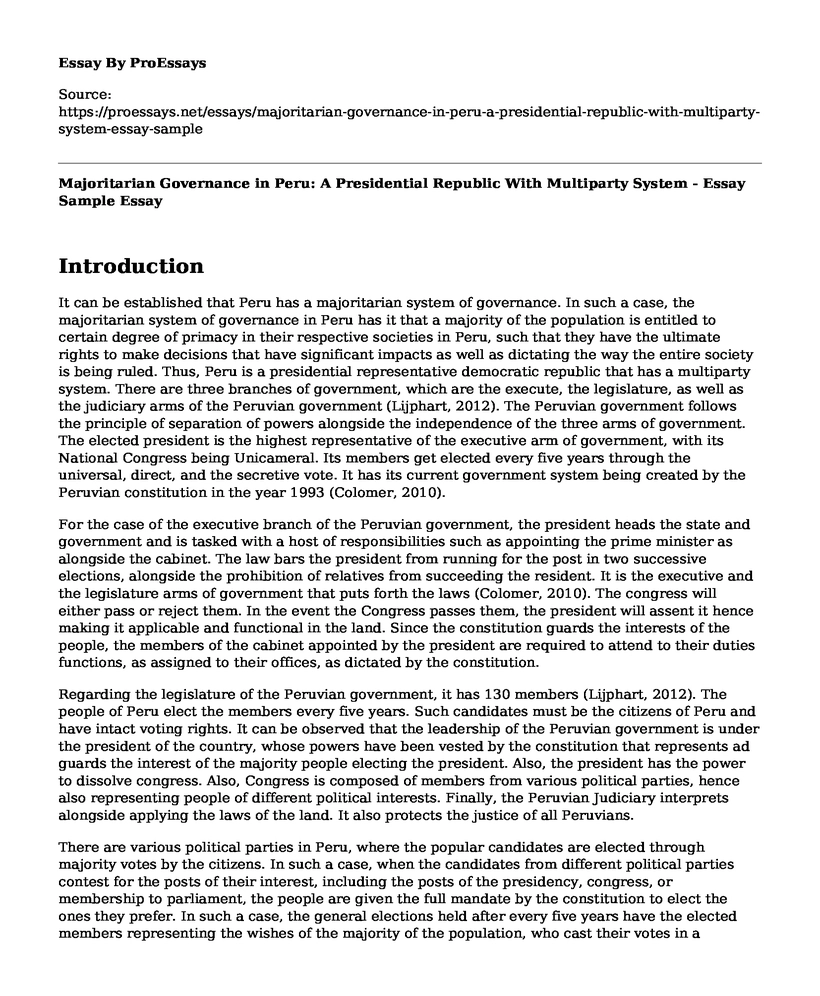Introduction
It can be established that Peru has a majoritarian system of governance. In such a case, the majoritarian system of governance in Peru has it that a majority of the population is entitled to certain degree of primacy in their respective societies in Peru, such that they have the ultimate rights to make decisions that have significant impacts as well as dictating the way the entire society is being ruled. Thus, Peru is a presidential representative democratic republic that has a multiparty system. There are three branches of government, which are the execute, the legislature, as well as the judiciary arms of the Peruvian government (Lijphart, 2012). The Peruvian government follows the principle of separation of powers alongside the independence of the three arms of government. The elected president is the highest representative of the executive arm of government, with its National Congress being Unicameral. Its members get elected every five years through the universal, direct, and the secretive vote. It has its current government system being created by the Peruvian constitution in the year 1993 (Colomer, 2010).
For the case of the executive branch of the Peruvian government, the president heads the state and government and is tasked with a host of responsibilities such as appointing the prime minister as alongside the cabinet. The law bars the president from running for the post in two successive elections, alongside the prohibition of relatives from succeeding the resident. It is the executive and the legislature arms of government that puts forth the laws (Colomer, 2010). The congress will either pass or reject them. In the event the Congress passes them, the president will assent it hence making it applicable and functional in the land. Since the constitution guards the interests of the people, the members of the cabinet appointed by the president are required to attend to their duties functions, as assigned to their offices, as dictated by the constitution.
Regarding the legislature of the Peruvian government, it has 130 members (Lijphart, 2012). The people of Peru elect the members every five years. Such candidates must be the citizens of Peru and have intact voting rights. It can be observed that the leadership of the Peruvian government is under the president of the country, whose powers have been vested by the constitution that represents ad guards the interest of the majority people electing the president. Also, the president has the power to dissolve congress. Also, Congress is composed of members from various political parties, hence also representing people of different political interests. Finally, the Peruvian Judiciary interprets alongside applying the laws of the land. It also protects the justice of all Peruvians.
There are various political parties in Peru, where the popular candidates are elected through majority votes by the citizens. In such a case, when the candidates from different political parties contest for the posts of their interest, including the posts of the presidency, congress, or membership to parliament, the people are given the full mandate by the constitution to elect the ones they prefer. In such a case, the general elections held after every five years have the elected members representing the wishes of the majority of the population, who cast their votes in a secretive manner (Lijphart, 2012). The candidates win by popularity, as well as the majority of votes cast. When the president takes office, he is mandated to appoint the members of the cabinet. In such a case, since the president represents the wishes of the majority of the votes cast, the appointed cabinet members will also be the representation of the wishes of the Peruvians. They will be assigned offices with various tasks, where they will be required to deliver government duties in the service of Peruvians in their entirety. Hence, the majoritarian system of governance in Peruvian influences the political system of the country through the conduction of state functions in a way as to represent the wishes of the majority of Peruvians.
References
Colomer, J. M. (2010). Constitutions, Elections, Governance.
Lijphart, A. (2012). Patterns of democracy: Government forms and performance in thirty-six countries. Yale University Press.
Cite this page
Majoritarian Governance in Peru: A Presidential Republic With Multiparty System - Essay Sample. (2023, Mar 21). Retrieved from https://proessays.net/essays/majoritarian-governance-in-peru-a-presidential-republic-with-multiparty-system-essay-sample
If you are the original author of this essay and no longer wish to have it published on the ProEssays website, please click below to request its removal:
- Research Proposal Example: Effects of Study Abroad and Its Contribution to Intercultural Competence
- President Eisenhower Doctrine Essay
- Policy Recommendation Essay Sample
- Essay Sample on Tech Shaping Politics: Impact of Social Media on Elections
- Essay Sample on U.S. Economy: Government Intervention vs. Laissez-Faire
- Separation of Powers & Federalist 51: Publius Defends Constitution - Essay Sample
- Abortion - Free Essay Example







